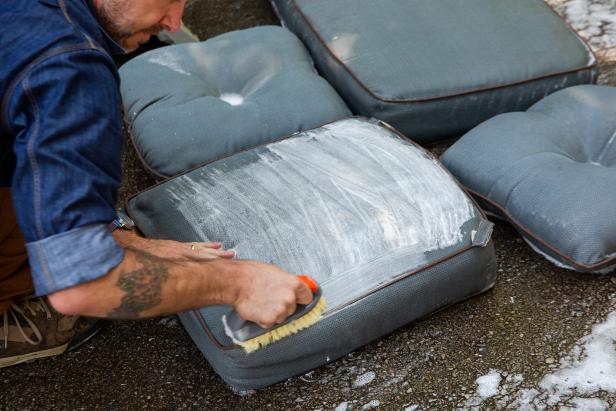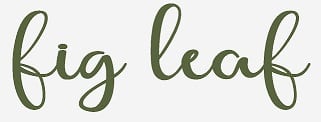The Best Ways to Clean your Cushions and Slipcovers

Cleaning Fig Leaf Cushion Covers
Our poly-knit slipcover material is machine washable. Simply wash them in cold water and let them air dry. It is that easy.
The waterproof material has a few more steps and they are not machine washable.
- Brush off all loose dirt with a soft bristle brush
- Evenly spray on a cleaning solution (can be simply water or a brand trusted soap.
- Gently and evenly scrub with a soft bristle brush.
- Allow cleaning solution (after it is brushed around) to sit and eliminate all dirt and marks.
- Rinse thoroughly until all the soap residue is gone.
- Allow for the fabric to air dry.
If any mold or mildew persists, try the bleach or white vinegar methods which are listed below.
Cleaning your Cushions
Cushions and pillows bring softness and style to outdoor furniture, but these soft additions endure a lot of wear and tear when exposed to the elements. The fabric can gather dirt, debris, mildew, tree sap, bird droppings, and other stains from outdoor use, so it’s important to know how to clean outdoor cushions and pillows to keep your seating area fresh and comfortable.
Plan to wash your patio furniture and cushions before storing them away for the season, or more frequently as stains happen. Depending on where they’re stored, you might also want to clean outdoor cushions and pillows before using them for the first time each year. Follow the steps below for the best way to clean outdoor cushions, including how to remove common stains like mildew from outdoor fabrics.
The Dish Soap Method
The Dish Soap Method is one of the easiest and simplest ways to rid your outdoor cushions of mold and mildew because it requires materials you already have in the house.
Tools and Materials:
- Soft-bristled brush
- Multi-surface cleaner
- ¼ cup of dish soap
- Bucket
- Gallon of water
- Hose
- Protective gloves (optional)
Instructions:
- Use your soft-bristled brush to remove excess dirt, mold, or mildew from the cushions.
- Spray the stained or moldy areas with your multi-surface cleaner.
- Use the soft-bristled brush to scrub the surface cleaner into the fabric.
- Thoroughly mix ¼ cup of dish soap with a gallon of water in a bucket.
- Wearing protective gloves, saturate the solution all over the cushions with the brush.
- Leave for five minutes before rinsing the cushions with a hose.
- Stand them upright to dry in a sunny spot.
The White Vinegar Method
The White Vinegar Method is a non-toxic and eco-friendly way to clean outdoor cushions of any fabric.
You can use distilled white vinegar for many tasks around the house, and one of those tasks—you guessed it—is removing mold and mildew from outdoor cushions.
However, this might not be the ideal method if your outdoor cushions are severely affected by mold or mildew. In that case, go with a more rigorous technique to get a deeper cleaning, such as the pressure washer or bleach methods.
Tools and Materials:
- Cloth
- Distilled white vinegar
- Clean spray bottle
- Liquid dish soap
- Large bowl
- Sponge
- Water
Instructions:
- If the cushion covers are removable, toss them into the washing machine and add 1 cup of distilled white vinegar to the fabric softener dispenser. White vinegar is acidic and can kill up to 82% of mold. Plus, it helps to prevent further mold outbreaks. If you don’t have removable cushion covers, continue with the next steps.
- Fill a spray bottle with distilled white vinegar.
- Spray it all over the cushions on both sides.
- Allow the vinegar to sit for 10 minutes.
- Mix three cups of warm water with one tablespoon of dish soap. Stir to dissolve.
- Soak a sponge in the mixture before scrubbing the cushions on both sides.
- Rinse the cushions with a clean damp cloth.
- Air out the cushions in a sunny spot until completely dry.
- Spray the white vinegar onto the cushions again to prevent further mold and mildew outbreaks.
The Bleach Method
Bleach kills fungi, germs, and bacteria, which is why this method is a great way to clean and disinfect your mold and mildew-stained outdoor cushions.
However, this method has a couple of downsides.
First, chlorine bleach can strip the pigment from colored cushion fabric. So, before you ruin your cushions and make matters much worse, make sure the material is bleachable.
Second, bleach is a toxic substance. It can irritate your skin and eyes and damage your lungs. If you prefer an eco-friendly cleaning method, skip this one.
When working with bleach, always wear protective gear such as gloves, an apron, and protective glasses.
Tools and Materials:
- ¾ cup of bleach
- One gallon of water
- Bucket
- Cloth or soft-bristled brush
- Garden hose
- A dry area, like a driveway or patio
- Tarp (so you don’t bleach the surface beneath)
- Protective wear, including gloves, apron, and glasses

